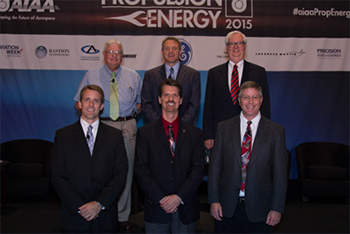Computational Fluid Dynamic Researchers and Experimental Fluid Dynamics Researchers Must Work Together Written 29 July 2015
Panelists: Moderator James Heidmann, NASA’s Glenn Research Center; Keith Blodgett, GE Aviation; Michael Mastaler, NASA; Richard “Dick” Scharnhost, Boeing Co.; Roy Shultz, Mira Facilities 2 Inc.; Paul Van Slooten, United Technologies Research Center
By Duane Hyland, AIAA Communications (2008-2017)

Government and aerospace industry experts debated the merits of computational fluid dynamics modeling and experimental fluid dynamics modeling during “Integrated Roles of Experimental Fluid Dynamics and Computational Fluid Dynamics,” a panel at the 2015 AIAA Propulsion and Energy Forum in Orlando, Florida. The conclusion: CFD and EFD practitioners must find ways to work together rather than dividing into separate camps.
CFD is the computer-driven analysis of flows in and around structures, and EFD is the use of a wind tunnel to do the same analysis.
Panel moderator James Heidman, an aerospace engineer with NASA’s Glenn Research Center, told the audience that, in his opinion, “there is a strong need for a collaborative effort for CFD and EFD going forward; they both have a lot in common, and the communities should communicate better.”
Paul Van Slooten of the United Technologies Research Center said that in 1975 it was believed that CFD would replace wind tunnel testing within two decades. He then pointed out that the declared death of wind tunnel technology was premature, with NASA, NASCAR and Mercedes-Benz just some of the companies who have built wind tunnel facilities in recent years. Every panelist agreed that although CFD use is expanding throughout testing circles, there are still some things that it can’t do well, so researchers must still use EFD methods.
Among the things that CFD can’t do well, but EFD can, according to all the panelists, are accurately predicting separated flows; modeling compressor stalls; modeling transonic separation; and modeling high angles of attack. The panelists said that traditional EFD testing in wind tunnels is still the best way to obtain data in those instances.
The best paradigm, Van Slooten explained is for CFD and EFD to work “side-by-side, complementing each other.”
Another problem with relying exclusively on CFD can be the “garbage-in, garbage-out” problem, as several panelists pointed out. If the operators don’t know how to work the data sets properly, you could end up in a situation where you have a lot of data but nothing that really matters, or even worse, just bad data.
In the end, both sides of CFD and EFD methods must talk to one another and work side-by-side.
As Roy Shultz of Mira Facilities 2 Inc. explained: “It’s relevant and important, and the people who need big data should be very interested in talking to the people who produce big data so we understand what the big data we are getting is.”
